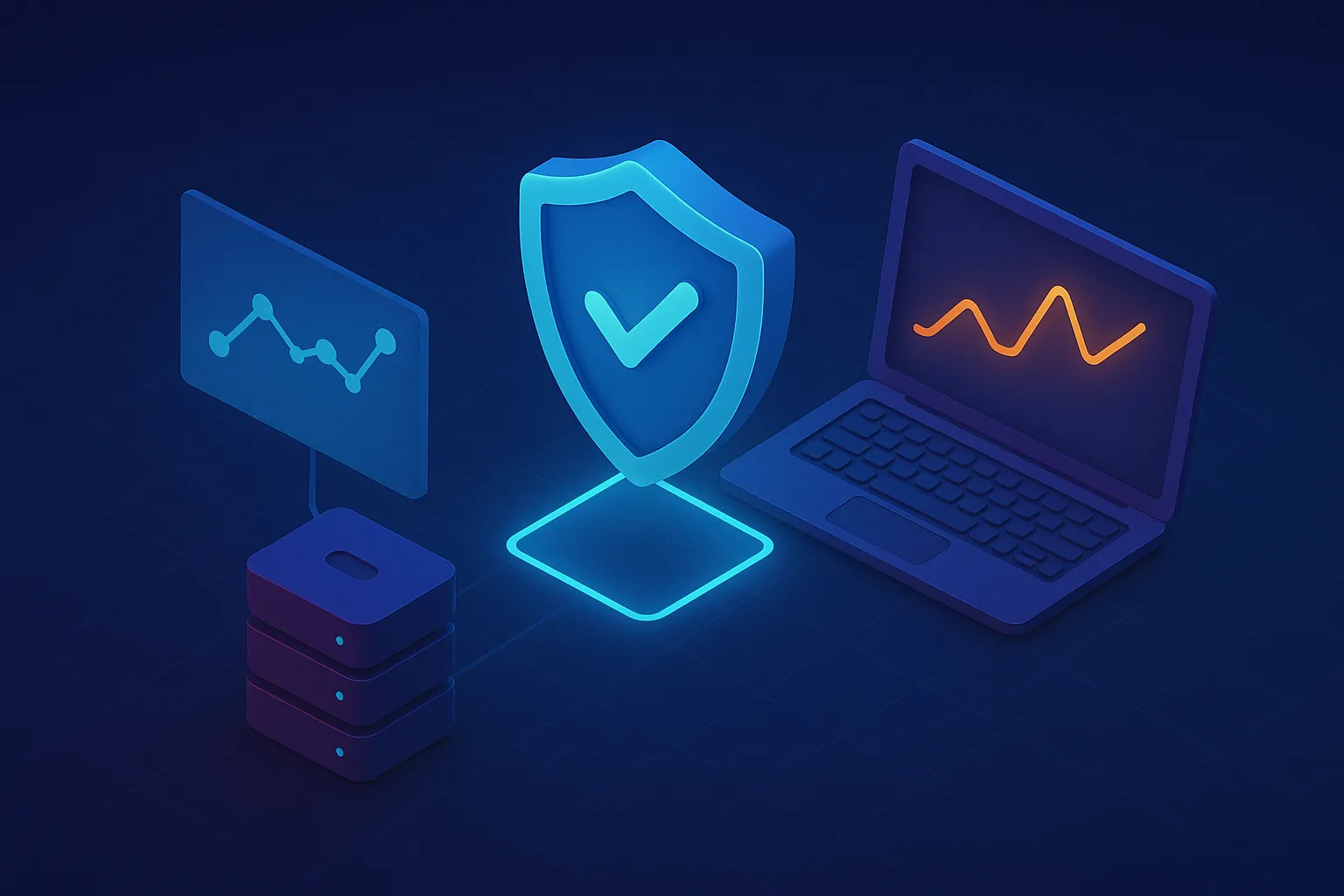October 23, 2025
October 23, 2025

IT systems rarely fail overnight, most breakdowns start as small, unnoticed issues that grow until they disrupt entire operations. The same goes for security breaches: a single overlooked update or undetected anomaly can open the door to costly attacks. That’s where proactive monitoring and support make the difference.
Instead of waiting for problems to appear, this approach allows businesses to anticipate risks, maintain system health, and act before any damage occurs. By combining real-time insights with preventive maintenance, proactive monitoring not only strengthens IT security but also ensures lasting system stability, the foundation of a resilient digital infrastructure.
Proactive monitoring and support is an IT management approach designed to prevent problems before they disrupt operations. Instead of reacting to failures after they happen, this method focuses on constant observation, early detection, and preventive action to keep systems healthy, secure, and optimized.
At its core, proactive monitoring involves real-time tracking of system performance, network activity, and application behavior. Advanced tools continuously collect and analyze data from CPU usage and server uptime to unusual traffic patterns to identify early warning signs of issues that could lead to downtime or security vulnerabilities.

Proactive support complements this monitoring by acting on insights before they escalate. That might mean applying software patches on schedule, rebalancing system loads to prevent bottlenecks, or addressing security anomalies the moment they appear. This proactive mindset helps businesses maintain consistent uptime, data integrity, and user trust.
The key difference between proactive and traditional reactive support lies in timing and intent.
For modern IT environments where even minutes of downtime can cause significant losses, proactive monitoring and support isn’t just a best practice, it’s a necessity. It builds resilience into the system architecture, minimizes risks, and ensures that technology continuously supports business goals rather than holding them back.
Cybersecurity threats rarely announce themselves, they evolve quietly, hiding within normal network activity until it’s too late. The strength of proactive monitoring lies in its ability to detect these subtle warning signs long before they turn into real breaches.
Cybersecurity threats rarely announce themselves, they evolve quietly, hiding within normal network activity until it’s too late. The strength of proactive monitoring lies in its ability to detect these subtle warning signs long before they turn into real breaches.
Proactive monitoring continuously scans every layer of the IT environment from servers and endpoints to cloud platforms and databases. By establishing a baseline of normal behavior, it helps detect unusual activity such as abnormal data transfers, unauthorized logins, or unexpected configuration changes. These early indicators often reveal intrusion attempts, malware infections, or insider threats that traditional, reactive systems might overlook.

Beyond detection, proactive monitoring plays a critical role in mitigation. Automated alert systems and intelligent dashboards allow IT teams to respond immediately, isolating affected systems or blocking malicious IPs before attackers can escalate their efforts. This reduces response time from hours to minutes, a crucial advantage when every second counts in cybersecurity.
Another key pillar of proactive security is regular patch and update management. Outdated software is one of the most common entry points for attackers. Proactive support ensures that systems stay current with the latest security patches, firmware updates, and configuration best practices, effectively closing known vulnerabilities before they’re exploited.
Proactive monitoring also strengthens compliance with industry standards and data protection regulations such as ISO 27001, GDPR, and SOC 2. Continuous auditing and reporting not only demonstrate accountability but also help businesses avoid costly penalties resulting from oversight or data breaches.
In essence, proactive monitoring transforms IT security from a defensive posture into an intelligent prevention strategy. It empowers organizations to stay ahead of evolving cyber threats, protect sensitive data, and maintain the trust of customers and stakeholders in an increasingly hostile digital landscape.
System stability is not achieved by chance, it’s the result of consistent care, foresight, and timely intervention. Proactive support ensures that IT environments remain healthy and predictable by addressing performance issues, configuration errors, or capacity bottlenecks before they lead to downtime.
Unlike reactive support, which deals with problems after they occur, proactive support is built around continuous improvement and preventive maintenance. It leverages data from monitoring tools to identify trends, for example, gradual increases in CPU load, storage usage, or response latency and acts on them early. This approach minimizes disruptions and keeps systems operating within optimal performance thresholds.

One of the most valuable aspects of proactive support is its ability to predict and prevent failures. Through log analysis and automated diagnostics, IT teams can spot hardware components nearing end of life, detect irregular memory leaks, or notice degrading database performance. By replacing or optimizing these elements in advance, businesses avoid sudden breakdowns that could halt critical operations.
Proactive support also contributes to balanced resource allocation. Regular system audits and capacity planning help ensure that applications and workloads are distributed efficiently, preventing overutilization in one area and underuse in another. This not only stabilizes performance but also extends the lifespan of infrastructure investments.
Furthermore, proactive support enhances service availability and user experience. Fewer incidents mean less downtime, smoother system updates, and more consistent access for both employees and customers. Over time, this reliability builds trust, not just in the IT team, but in the entire organization’s ability to deliver uninterrupted service.
In short, proactive support turns IT management from a constant firefight into a well-orchestrated, data-driven discipline. By staying one step ahead of potential issues, businesses can maintain stable, efficient, and scalable systems that support long-term growth with confidence.
Technology downtime isn’t just a technical inconvenience, it’s a business problem. Every minute of disruption can translate into lost revenue, reduced productivity, and reputational damage. By shifting from a reactive mindset to proactive monitoring and support, businesses can transform IT from a cost center into a strategic driver of reliability and growth.
The most immediate business benefit is cost efficiency. Preventing system failures is almost always less expensive than fixing them. Proactive monitoring helps reduce emergency maintenance, data recovery, and unplanned hardware replacements, all of which can quickly erode IT budgets.
By identifying issues early, companies gain predictable operational costs and a better return on their infrastructure investments. The shift from reactive firefighting to preventive care doesn’t just save money, it frees up valuable time and resources that can be redirected toward innovation and growth.
With proactive support, organizations experience fewer interruptions and faster recovery times. Critical services from internal databases to customer-facing platforms, stay available when they’re needed most.
This consistent uptime improves employee productivity and builds customer confidence, two factors that directly influence profitability. Fewer outages mean less time spent troubleshooting, smoother user experiences, and higher overall performance across departments.
Proactive monitoring also provides the insights needed to make smarter business decisions. Continuous visibility into system health allows IT leaders to anticipate demand, plan upgrades, and allocate resources more effectively.
Instead of reacting to crises, teams can focus on optimization and long-term innovation, turning IT into a true business enabler. Beyond cost and performance, this approach enhances reputation: companies that deliver stable and secure digital experiences are seen as more trustworthy, capable, and forward-thinking.
In essence, proactive monitoring and support do more than protect technology, they protect business momentum. By minimizing risk, improving uptime, and strengthening customer trust, they create the foundation for sustainable growth in an increasingly digital economy.
At Serdao, we believe that strong IT systems are built on more than just technology,they’re built on trust, transparency, and consistent care. Our proactive monitoring and support services are designed to keep your infrastructure secure, stable, and performing at its best, so your teams can focus on growth instead of firefighting.
We start by giving you real-time visibility into your IT environment. Every server, application, and network component is continuously monitored through intelligent dashboards that highlight performance trends and potential risks. This level of insight allows us and you, to anticipate issues early and act before they become problems.
Security and stability go hand in hand, so we also focus on regular maintenance, patch management, and performance tuning. Updates are applied proactively to close vulnerabilities, optimize workloads, and maintain compliance with your organization’s security standards.
What truly sets Serdao apart is our partnership mindset. We don’t just monitor your systems, we become an extension of your IT team. Whether it’s optimizing configurations, analyzing performance reports, or providing strategic recommendations, our goal is to ensure that your technology evolves smoothly alongside your business.
In every engagement, Serdao’s promise remains the same: keep your systems secure, your operations stable, and your business one step ahead.
Conclusion
Proactive monitoring and support are no longer optional, they’re essential foundations for a secure, stable, and resilient IT environment. By preventing issues before they escalate and continuously optimizing system performance, businesses can stay ahead of disruptions, reduce downtime, and focus on what truly matters: growth and innovation.
At Serdao, we bring this proactive mindset to every partnership. Our experts combine advanced tools, real-time insights, and human expertise to ensure your systems are always running at their best. With Serdao, you don’t just react to problems, you stay one step ahead of them.